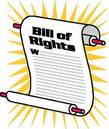Concepts for Kids
1. The men who created the government of the United States wanted to be sure that Americans stayed free. They wrote a paper called the United States Constitution that told how the government would work.
2. Ten more rules were added at the end. These rules are called the Bill of Rights. They tell Americans what freedoms the government may not take away from them. 3. The Bill of Rights are very important for protecting liberty for Americans. Online ResourcesThe Bill of Rights in Simple Language
Kids Encyclopedia kid friendly explanation Once your child knows which rights are protected by which amendments, he or she can play the Bill of rights Concentration game game 1 with cards face up game with cards face down game 2 with cards face down Family ActivityHelp your child create an 8.5" x 11" spreadsheet with ten cells. Add The Bill of Rights to the header. In small font, type a summary of one amendment in each cell. Help your child add large, appropriate clipart for each amendment. Print the results. These illustrations should provide a visual reference to help your child remember the Bill of Rights.
|
Related LiteratureThe Bill of Rights
by Norman Pearl Finding short, simple books about the Bill of Rights is difficult. This one is a gem. In 24 pages it describes why and when the document was written, with succinct, kid-friendly summaries of the first ten amendments. The illustrations resemble colorful wood carvings. The Bill of Rights in Translation: What it Really Means (revised edition) by Amie Jane Leavitt (ages 8 and up) Using photographs, period artwork, and clever background and font changes, this well-designed book explains the Bill of Rights on a variety of levels. The original text appears printed on an aged document, the translation into modern wording on the facing page is in white. Blue boxes and lines connect added facts, and yellow "stickies" contain definitions. At the end are short chapters chronicling the story of the Bill of Rights and preservation of the original document. The Bill of Rights, a New True Book (May, 1987) by Warren Colman In simple language, this book describes the reasons for the addition of the Bill of Rights to the US Constitution and how rights protect people from unfair rulers. Without unnecessary detail, each amendment is described. When appropriate, short discussions of what can happen when rights are absent is included. The Bill of Rights (a True Book) by Christine Taylor-Butler Colorful photographs on glossy pages make this an attractive book. Though the chapters are short, the text level is aimed at older elementary students and above. Captions and diagrams add interest. Most of the book is devoted to the history of the Bill of Rights, with only a few pages summarizing their meaning. |
Proudly powered by Weebly



